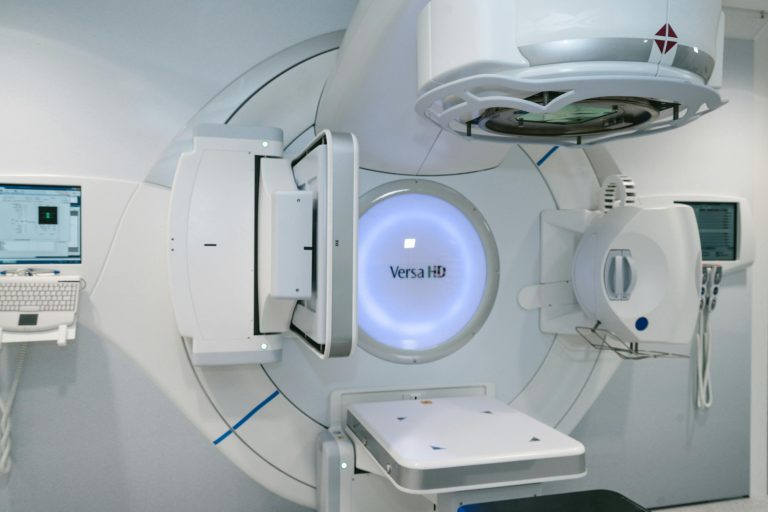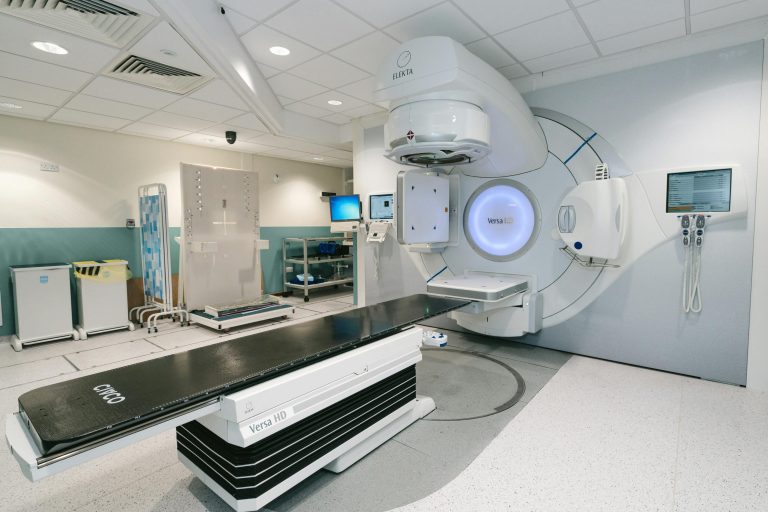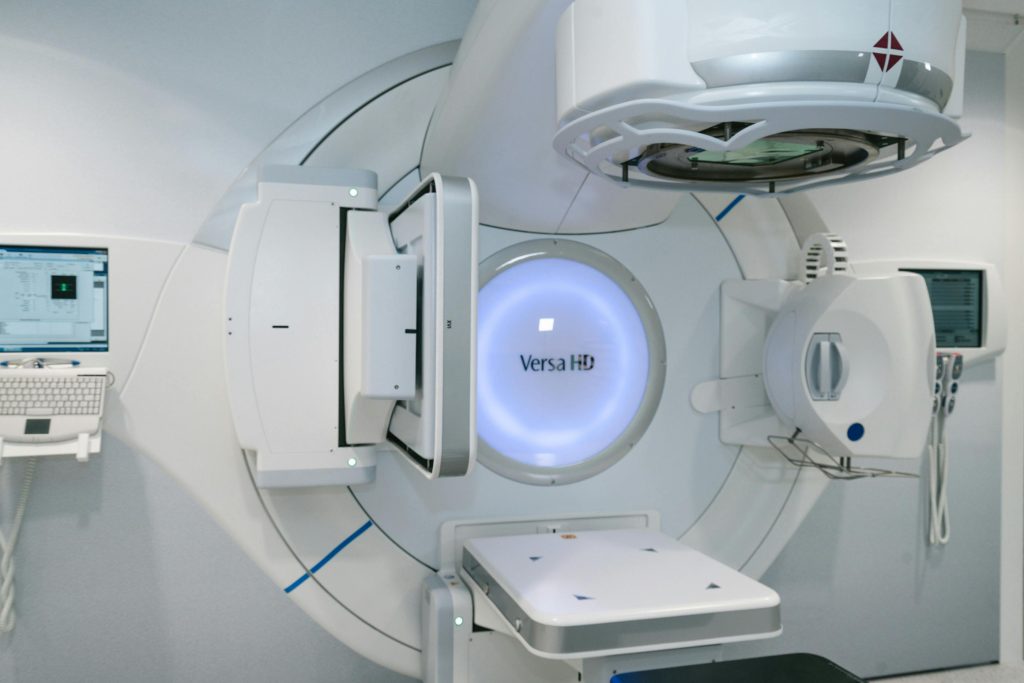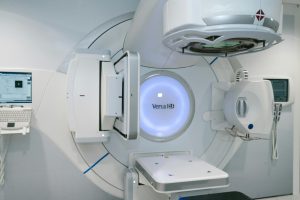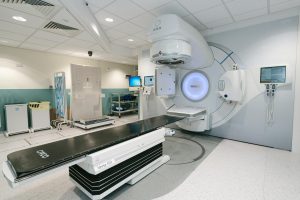This type of room requires careful consideration of safety, functionality, and patient comfort. Here are the key design principles and elements:
1. Radiation Shielding and Safety
- Walls and Doors: LINAC rooms must be constructed with high-density materials, like lead or concrete, to contain radiation. Typically, walls are 3 to 8 feet thick, depending on the energy output of the LINAC machine.
- Door Design: Doors should be specially shielded with lead or other high-density materials and have interlocking safety systems to prevent accidental exposure.
- Maze Entrance: Instead of direct access, a maze-like entry design helps limit radiation leakage by ensuring radiation doesn’t exit directly through the door. This reduces the need for heavy door shielding.
2. Room Layout and Equipment Positioning
- Gantry Position: The LINAC machine’s gantry (the rotating part) needs space for full 360° movement. Ensure adequate clearance around the machine to allow for patient alignment, treatment delivery, and maintenance.
- Treatment Table (Couch): Positioned in the center of the room, aligned with the gantry. The table should be adjustable and made of non-reflective material to avoid interference with imaging systems.
- Control Area: The control room is often adjacent to the treatment room, with lead-glass windows to view the patient. This area houses monitors and controls, enabling technicians to monitor and adjust treatment settings.
3. Patient Comfort
- Ambient Design: Patients may feel anxious, so adding soft lighting, calming colors, and ambient music can help create a relaxing atmosphere.
- Temperature and Ventilation: The room should have controlled ventilation and temperature regulation to ensure comfort, as the machine can generate heat.
- Emergency Intercom: An intercom system allows patients to communicate with operators in case they feel uncomfortable or need assistance.
4. Imaging and Monitoring Equipment
- Imaging Systems: Many LINAC treatment rooms incorporate CT or MRI scanners for image-guided radiation therapy (IGRT), ensuring precise targeting of the tumour.
- CCTV and Audio Monitoring: Installing cameras and audio equipment allows the operator to monitor the patient’s position and condition during treatment, enhancing safety and response time if the patient needs help.
5. Electrical and Mechanical Requirements
- Power Supply: LINAC machines require a stable, high-power electrical supply with backup generators to avoid interruptions.
- Ventilation for Heat Dissipation: LINAC machines generate substantial heat, so air conditioning and proper ventilation are necessary to keep equipment from overheating.
- Flooring: Durable and anti-static flooring materials help in maintaining a sterile environment while protecting sensitive equipment from static discharge.
6. Room Dimensions and Clearance
- Size: Typical LINAC rooms are around 20 to 25 feet long and 15 to 20 feet wide. This allows adequate space for the machine, patient couch, and clearances for movement.
- Ceiling Height: The ceiling height should generally be around 9-10 feet to accommodate overhead equipment and gantry movement without obstruction.
7. Radiation Safety Protocols and Signage
- Signage and Warning Lights: Include warning lights and signs outside the room that indicate when radiation is in use. Lights should turn on automatically when the machine is active.
- Emergency Stops: Emergency stop buttons should be accessible inside and outside the treatment room to immediately halt radiation if necessary.
8. Quality Control and Maintenance
- Easy Access for Maintenance: The design should consider how technicians will access the LINAC machine for routine maintenance and repairs.
- Storage for Accessories: Additional space may be required for storage of immobilization devices, bolus materials, and other treatment accessories.
The details on some specific aspects of LINAC room design are as follows:
1. Radiation Shielding and Safety
- Shielding Materials: Shielding requirements depend on the LINAC machine’s energy output. Lower-energy machines (6 MV) require less shielding than high-energy machines (up to 25 MV). Standard materials include:
- Concrete: Generally used due to its cost-effectiveness and availability. Thicknesses range from 3 to 8 feet, depending on the machine.
- Lead Lining: Used indoors and other sensitive areas where heavy concrete isn’t practical. Lead sheets are dense enough to block radiation in smaller spaces.
- High-Density Blocks: Some facilities use modular high-density blocks, which allow for flexible room design while meeting radiation shielding standards.
- Shielded Entry Doors: LINAC treatment rooms typically have heavy, motorized doors lined with lead. Some doors may be up to a foot thick and can be extremely heavy. Motorized, interlocked doors are important for safety, as they ensure that no one can enter while the machine is active.
- Room Shape and Maze Configuration: A maze-like entrance reduces radiation exposure outside the room. The layout is designed so radiation beams cannot directly exit through doors, thereby reducing the need for additional shielding. This approach also helps lower the overall room construction cost by reducing the amount of lead required for shielding the entry.
2. Room Layout and Equipment Positioning
- Gantry Position and Movement Range: The gantry, which is the large rotating part of the LINAC, must be able to move 360° around the patient without obstruction. The central area of the room should be clear to accommodate this rotation, allowing the gantry to deliver radiation from multiple angles.
- Treatment Couch and Positioning Devices:
- Height Adjustability: The couch needs to be height-adjustable and maneuverable to align precisely with the LINAC beam’s isocenter (the point in space around which the machine rotates and focuses the radiation).
- Immobilization Devices: For accurate targeting, patients may need to be immobilized, particularly for head and neck cancers. Devices like thermoplastic masks, body molds, and vacuum cushions are often used, so additional storage for these accessories near the treatment couch is helpful.
- Control Room Position: The control room is typically located adjacent to the LINAC room with direct, shielded visibility into the treatment area. It includes multiple monitors and computers where operators can view imaging data, manage patient setup, and control the machine.
- Lead Glass Windows: These allow operators to observe patients directly during the procedure while being protected from radiation.
- Intercom System: To maintain constant communication, intercoms allow operators to speak to patients throughout the treatment session.
3. Patient Comfort and Experience
- Ambient Lighting: Radiation treatment can be intimidating for patients, especially since they are alone in the room during treatment. Soft, dimmable lighting, often with calming colours like blues and greens, helps create a more relaxing environment. Some facilities use ceiling-mounted LED panels with images of nature or sky scenes, giving patients something soothing to look at while lying on the treatment couch.
- Noise Reduction: LINAC machines produce a fair amount of mechanical noise due to moving parts and ventilation fans. Soundproofing the room or using softer materials in the ceiling can help reduce the noise level and make the environment less intimidating for patients.
- Temperature Control: LINAC rooms can become warm due to the machine’s operation. Separate, adjustable air conditioning systems with quiet operation help keep patients comfortable without adding to noise levels. Proper ventilation also ensures consistent air circulation, which is important in keeping the room sterile and comfortable.
4. Advanced Imaging and Monitoring Equipment
- Image-Guided Radiation Therapy (IGRT) Integration: Many LINACs come with integrated imaging systems to help ensure precise tumour targeting during each session. IGRT technology enables real-time imaging (like CBCT – cone-beam computed tomography) and can capture images moments before treatment begins, allowing for adjustments based on slight changes in the patient’s positioning or anatomy.
- CCTV Monitoring and Audio Communication: For safety, hospitals often equip LINAC rooms with closed-circuit television (CCTV) cameras. This lets the operator monitor patients during the entire session. The audio communication system is bidirectional, meaning patients can speak to the operator if they feel discomfort or need to stop.
5. Power Supply and Mechanical Requirements
- Stable Power Source: LINAC machines require a high-power supply with voltage stabilizers to ensure uninterrupted function. Unstable power can lead to interruptions in treatment, which may affect patient safety and machine integrity. Hospitals typically provide a dedicated electrical line for LINAC systems, and some facilities have backup power generators to prevent downtime during outages.
- Heat Dissipation: LINAC equipment generates a substantial amount of heat during operation, so cooling is essential. The room’s ventilation and cooling systems need to be robust to prevent overheating, especially during extended use. An HVAC (Heating, Ventilation, and Air Conditioning) system with individual control for the LINAC room ensures optimal temperature management.
6. Radiation Safety Protocols and Signage
- Warning Lights and Visual Signals: Visual cues like warning lights at the entrance and inside the control room help communicate the LINAC’s operational status. When radiation is active, lights automatically turn on, signalling operators and preventing accidental exposure.
- Emergency Stop and Access Controls: Emergency stop buttons are located inside and outside the room, allowing either the patient or technician to stop radiation immediately. Hospitals also implement controlled access systems, where only authorized personnel can enter the LINAC room.
- Radiation Monitoring Devices: Dosimeters and other radiation monitoring tools can be installed in and around the LINAC room to ensure compliance with radiation safety levels, protecting both patients and staff from excessive exposure.
7. Maintenance and Quality Control
- Routine Calibration and Quality Assurance: LINAC systems must undergo regular calibration to ensure they deliver the correct radiation dose. Medical physicists and technicians perform these checks frequently, including verifying beam alignment, radiation dose accuracy, and mechanical functions.
- Service Access Points: Design considerations should allow for easy access to LINAC machine components for maintenance. Some parts of the LINAC, like the cooling system, power components, and gantry, may require regular checks, so the room layout should not impede these functions.
- Accessory Storage: Storage closets or cabinets within or near the LINAC room can hold treatment accessories like bolus materials (used to alter radiation depth), immobilization masks, and positioning cushions. This storage area helps streamline the setup process, allowing staff to access necessary items quickly.
8. Room Dimensions and Clearance
- Room Size for Workflow Optimization: A typical LINAC room should ideally measure around 20-25 feet in length and 15-20 feet in width, allowing sufficient space for all equipment, patient setup, and staff movement. The layout should support an efficient workflow where patients can enter, prepare, and exit smoothly, minimizing their time in the treatment area.
- Ceiling Height for Equipment Installation: LINAC rooms generally require higher ceilings, often around 9-10 feet, to accommodate the gantry’s full range of motion without obstruction. High ceilings also allow for overhead-mounted equipment, such as imaging systems, without crowding the treatment space.
Designing a LINAC treatment room involves an interplay of technology, patient experience, and stringent safety measures. By considering each aspect, from shielding and power requirements to patient comfort and accessibility, hospitals can create a space that not only maximizes the LINAC’s treatment potential but also enhances the experience and safety of both patients and staff. Would you like more details on any specific construction material, patient flow, or additional technological aspects?


